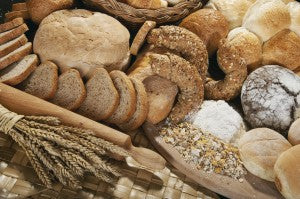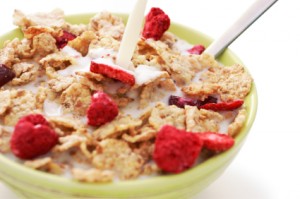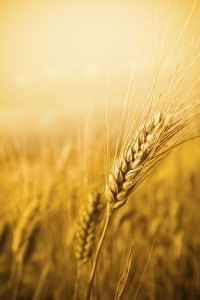
Think of breads and cereals as the coal that fuels the fire that keeps you on your toes all day. By storing wheat, flour, and other grains, you have the base of the bread and cereals group. Bread isn't the only thing you can make with stored grain. You can make homemade pasta, soups, and more. You can even use wheat as a healthy and thrifty way to stretch your meat budget. It's just a matter of knowing what to store and how to use it.
Breads and Cereals in Your Diet
Breads, cereals, pasta, and rice are rich in complex carbohydrates (starches), which your body needs for energy to make it through the whole day. This fuel is so important that nutritionists recommend that 50% or more of your daily calories come from complex carbohydrates.
Essential for a low-fat diet. Years ago, starchy foods made with grains got a bad reputation for being fattening. Now nutritionists know that it's what you put on foods like bread and pasta, such as butter and cheese, that adds the calories and fat. And grain products will expand in your stomach, satisfying you even if you eat less.
An ideal non-meat protein source. Some people are concerned that their food storage may be lacking in protein, since it's difficult to store meat and other protein-rich foods. However, when paired with beans and grains (particularly wheat and rice) they form a complete protein. This is a great way to ensure your body gets the protein it needs for muscle growth and repair.
High in cancer-fighting fiber. A lot of health attention is on fiber these days. The insoluble fiber in the bran of wheat helps clean out the digestive system. And bran is also known to prevent the formation of intestinal carcinogens (cancer causing elements). By eating whole wheat products, you can avoid adding fiber artificially to your diet.

Store Wheat for Health and Variety
There's a reason why wheat has been referred to as "the staff of life." Wheat ranks first in nutritional value. It's an excellent source of complex carbohydrates and micro nutrients. Enriched white flour, in comparison, has less than 20% of the nutrients that ground wheat has. Wheat is the original low-fat food!
Wheat is inexpensive. Pound for pound, wheat is one of the least expensive foods available. By using wheat products, you can eliminate the need for using store-bought, overpriced, and over-processed goods.
Wheat adds variety to your food storage. Most people think of using wheat only as flour in bread. But you can do so much more with wheat. You can use wheat as an easy and tasty meat extender for hamburgers, meatloaf, lasagna, pizza, spaghetti sauce, sloppy joes, chili, chowders, and soups. Just crack the wheat in a blender or mill on a coarse setting. After cooking your hamburger and draining the fat, add two cups water and a half cup uncooked cracked wheat. Stir and simmer at least 30 minutes.
Cracked wheat makes a delicious hot cereal. And not only can you use wheat flour to make bread, you can also use it in noodles, pie crusts, pastries, muffins, cookies...the list is almost endless!
Wheat is easy to store. Wheat stores almost indefinitely if stored properly at room temperature or cooler. Enriched white flour on the other hand only stores for a few months (unless nitrogen-packed). When storing wheat in superpails or #10 cans, make sure it's not stored directly on the cement floor. This prevents cans from rusting and pests from contaminating your wheat. And wheat is best stored in round food storage containers. Why? Because wheat gives off heat and square containers stacked closely together don't allow this heat to escape.

What kind of wheat is best for me?
Wheat is wheat, right? Not necessarily. Will you make nutty loaves of deep brown bread or light, flaky pastries with your wheat? It all depends upon the best ways to prepare them. You should store a variety of wheat, (at least two different kinds) so you always have the right wheat for your baking needs. Experiment and Replace out which ones your family enjoys!
Hard Red Winter Wheat
High in protein and fiber, it's the most common wheat available. Excellent for making hearty whole wheat loaves. Can also be used to extend red meat in meals.
Hard White Winter Wheat
Also high in protein and fiber, it has a more delicate flavor than hard red wheat. Used to make light and fluffy bread. Great for rolls and scones. Can be used to extend white meat in meals.
Soft White Wheat
This is the wheat used to make flaky pastries, pie crusts, cakes, crackers and breakfast cereals. It's lower in gluten and protein than most wheat, so it is not recommended to use in breads.






1 comment
sandy
Please give us recipes for whole wheat.